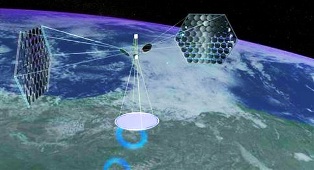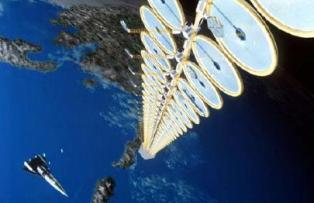Categories: Featured Articles » Controversial issues
Number of views: 18219
Comments on the article: 1
Space Solar Power Station - Fiction or Reality?
Science fiction writers sometimes invent projects that are many years ahead of the development of technology. Jules Verne in his first story described a balloon, the rise of which can be changed by heating gas - now such balloons fly around the world. The beloved in Russia British science fiction writer Arthur Clark in 1945 proposed launching communication satellites into geostationary orbits, and nine years later indicated the possibility of using spacecraft to predict weather. Both ideas have long been put into practice with great benefit to humanity.
Isaac Asimov, a classic of American science fiction, also pampered readers with many brilliant technical forecasts. One of them is contained in a short story by Reason, which appeared in the April 2004 issue of Astounding Science Fiction (in Russian, it was first published in the cult collection “I, Robot” under the heading “Logic”).
The action takes place on one of the space stations that supply energy to our planet. Its spherical body is surrounded by panels with photocells that convert the sun's rays into electric current, which feeds a gigantic microwave radiation generator. It is sent by a thin beam to a receiving station on Earth and there again converted into electricity. Simple, elegant and, most importantly, is absolutely feasible from the point of view of physics. True, fans of Asimov will recall that the robot Kyuty, responsible for the emitter’s work, rebelled, but ultimately the story ends with a happy ending.

It is very possible that in just seven years, the Asimov idea will become a reality - though without robots for now. It intends to implement the California-based Solaren Corporation, created by a group of engineers in the aerospace industry. The company has already convinced Pacific Gas & Electric, the largest energy corporation, to deliver the electricity it produces to residents of Fresno County. PG&E has so far promised to purchase 200 thousand kilowatts of space electricity, and this is only the beginning. Solaren executives believe that over time, its satellites will be able to generate from 200 million to 4, 800 million kilowatts - this is consistent with the capabilities of one or three modern nuclear power plants. Needless to say, not weak.
How will this wonderful project be carried out? Solaren is talking about several satellites launched into circular geostationary orbits at an altitude of about 36 thousand km. Satellites deployed mirrors of many kilometers in size, made of a thin shiny film. These reflectors will collect the sun's rays and direct them to the batteries of solar cells - exactly as in the story of Asimov. Then, solar energy will be converted into electromagnetic radiation and aimed at the antennas of the ground receiving station - again, in full accordance with the plot of the science fiction writer.
The only difference is that Solaren will transmit energy to the Earth not with the help of microwave waves that are dangerous to humans, but with completely harmless radio waves. To do this, you need to build a series of receiving antennas and place them on a plot of several square meters. kilometers. But on the other hand, the rays of the space power station, even when defocused, will certainly not burn anyone or anything (which almost happened in the Asimov story).

The firm claims that its satellites will be able to supply solar energy to 250 thousand residential buildings in the Fresno district. At the same time, the announced project price is not so high: $ 2 billion. Solaren is confident that the cost of space energy will not exceed the price of electricity from wind generators and ground-based solar stations.
A similar project is now being developed by another American company, Space Energy. They are also thinking about this in the Land of the Rising Sun. The Japanese Office for the Study of Outer Space has recently begun testing a prototype emitter that can transmit solar energy to the earth in the form of microwaves - exactly like Azimov’s. If the test is successful, the agency will begin planning artificial satellites that will be able to supply clean electricity to half a million homes. True, the Japanese do not expect to launch the first such satellite before 2030.

Of course, while such projects may seem exactly what they seemed in the middle of the last century, pure fantasy. The world record for wireless transmission of decent amounts of energy has been held since 1975. NASA experts then managed to transmit a microwave power of 30 kilowatts per mile, and since then this figure has not been blocked by anyone. Solaren promises to pump immeasurably greater power over distances of tens of thousands of kilometers. However, her leadership claims that the technologies necessary for this already exist.
If this is not Manilovism, then in 2016 or so, Voice of America will be able to announce the start of work of the world's first space solar power station. In the end, the wait is not long.
Alexey Levin
See also at bgv.electricianexp.com
:
